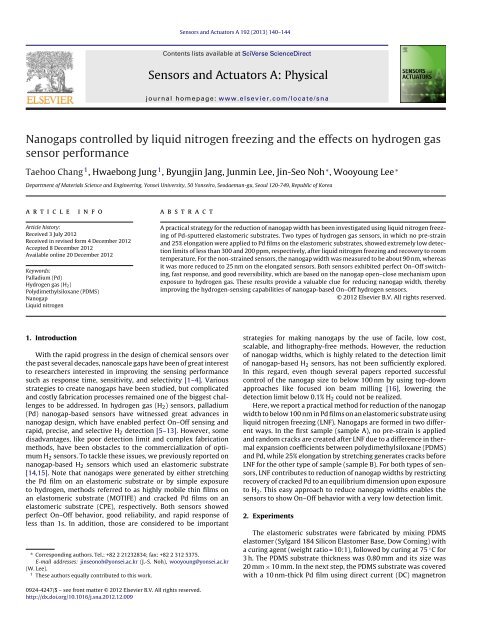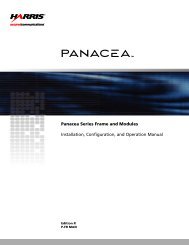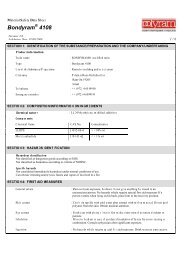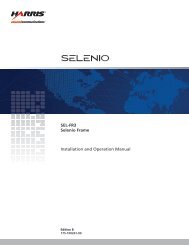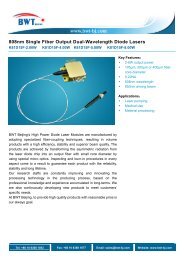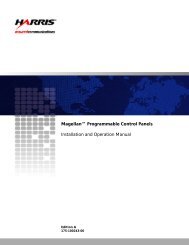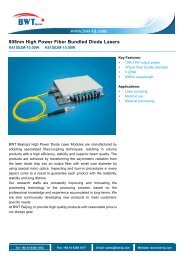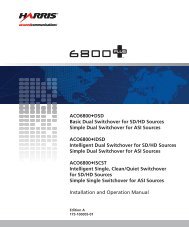Nanogaps controlled by liquid nitrogen freezing and the ... - biznine.kr
Nanogaps controlled by liquid nitrogen freezing and the ... - biznine.kr
Nanogaps controlled by liquid nitrogen freezing and the ... - biznine.kr
You also want an ePaper? Increase the reach of your titles
YUMPU automatically turns print PDFs into web optimized ePapers that Google loves.
Sensors <strong>and</strong> Actuators A 192 (2013) 140– 144<br />
Contents lists available at SciVerse ScienceDirect<br />
Sensors <strong>and</strong> Actuators A: Physical<br />
jo u rn al hom epage: www.elsevier.com/locate/sna<br />
<strong>Nanogaps</strong> <strong>controlled</strong> <strong>by</strong> <strong>liquid</strong> <strong>nitrogen</strong> <strong>freezing</strong> <strong>and</strong> <strong>the</strong> effects on hydrogen gas<br />
sensor performance<br />
Taehoo Chang 1 , Hwaebong Jung 1 , Byungjin Jang, Junmin Lee, Jin-Seo Noh ∗ , Wooyoung Lee ∗<br />
Department of Materials Science <strong>and</strong> Engineering, Yonsei University, 50 Yonseiro, Seodaemun-gu, Seoul 120-749, Republic of Korea<br />
a r t i c l e i n f o<br />
Article history:<br />
Received 3 July 2012<br />
Received in revised form 4 December 2012<br />
Accepted 8 December 2012<br />
Available online 20 December 2012<br />
Keywords:<br />
Palladium (Pd)<br />
Hydrogen gas (H2)<br />
Polydimethylsiloxane (PDMS)<br />
Nanogap<br />
Liquid <strong>nitrogen</strong><br />
1. Introduction<br />
a b s t r a c t<br />
With <strong>the</strong> rapid progress in <strong>the</strong> design of chemical sensors over<br />
<strong>the</strong> past several decades, nanoscale gaps have been of great interest<br />
to researchers interested in improving <strong>the</strong> sensing performance<br />
such as response time, sensitivity, <strong>and</strong> selectivity [1–4]. Various<br />
strategies to create nanogaps have been studied, but complicated<br />
<strong>and</strong> costly fabrication processes remained one of <strong>the</strong> biggest challenges<br />
to be addressed. In hydrogen gas (H 2) sensors, palladium<br />
(Pd) nanogap-based sensors have witnessed great advances in<br />
nanogap design, which have enabled perfect On–Off sensing <strong>and</strong><br />
rapid, precise, <strong>and</strong> selective H 2 detection [5–13]. However, some<br />
disadvantages, like poor detection limit <strong>and</strong> complex fabrication<br />
methods, have been obstacles to <strong>the</strong> commercialization of optimum<br />
H 2 sensors. To tackle <strong>the</strong>se issues, we previously reported on<br />
nanogap-based H 2 sensors which used an elastomeric substrate<br />
[14,15]. Note that nanogaps were generated <strong>by</strong> ei<strong>the</strong>r stretching<br />
<strong>the</strong> Pd film on an elastomeric substrate or <strong>by</strong> simple exposure<br />
to hydrogen, methods referred to as highly mobile thin films on<br />
an elastomeric substrate (MOTIFE) <strong>and</strong> cracked Pd films on an<br />
elastomeric substrate (CPE), respectively. Both sensors showed<br />
perfect On–Off behavior, good reliability, <strong>and</strong> rapid response of<br />
less than 1s. In addition, those are considered to be important<br />
∗ Corresponding authors. Tel.: +82 2 21232834; fax: +82 2 312 5375.<br />
E-mail addresses: jinseonoh@yonsei.ac.<strong>kr</strong> (J.-S. Noh), wooyoung@yonsei.ac.<strong>kr</strong><br />
(W. Lee).<br />
1 These authors equally contributed to this work.<br />
0924-4247/$ – see front matter ©<br />
2012 Elsevier B.V. All rights reserved.<br />
http://dx.doi.org/10.1016/j.sna.2012.12.009<br />
A practical strategy for <strong>the</strong> reduction of nanogap width has been investigated using <strong>liquid</strong> <strong>nitrogen</strong> <strong>freezing</strong><br />
of Pd-sputtered elastomeric substrates. Two types of hydrogen gas sensors, in which no pre-strain<br />
<strong>and</strong> 25% elongation were applied to Pd films on <strong>the</strong> elastomeric substrates, showed extremely low detection<br />
limits of less than 300 <strong>and</strong> 200 ppm, respectively, after <strong>liquid</strong> <strong>nitrogen</strong> <strong>freezing</strong> <strong>and</strong> recovery to room<br />
temperature. For <strong>the</strong> non-strained sensors, <strong>the</strong> nanogap width was measured to be about 90 nm, whereas<br />
it was more reduced to 25 nm on <strong>the</strong> elongated sensors. Both sensors exhibited perfect On–Off switching,<br />
fast response, <strong>and</strong> good reversibility, which are based on <strong>the</strong> nanogap open–close mechanism upon<br />
exposure to hydrogen gas. These results provide a valuable clue for reducing nanogap width, <strong>the</strong>re<strong>by</strong><br />
improving <strong>the</strong> hydrogen-sensing capabilities of nanogap-based On–Off hydrogen sensors.<br />
© 2012 Elsevier B.V. All rights reserved.<br />
strategies for making nanogaps <strong>by</strong> <strong>the</strong> use of facile, low cost,<br />
scalable, <strong>and</strong> lithography-free methods. However, <strong>the</strong> reduction<br />
of nanogap widths, which is highly related to <strong>the</strong> detection limit<br />
of nanogap-based H 2 sensors, has not been sufficiently explored.<br />
In this regard, even though several papers reported successful<br />
control of <strong>the</strong> nanogap size to below 100 nm <strong>by</strong> using top-down<br />
approaches like focused ion beam milling [16], lowering <strong>the</strong><br />
detection limit below 0.1% H 2 could not be realized.<br />
Here, we report a practical method for reduction of <strong>the</strong> nanogap<br />
width to below 100 nm in Pd films on an elastomeric substrate using<br />
<strong>liquid</strong> <strong>nitrogen</strong> <strong>freezing</strong> (LNF). <strong>Nanogaps</strong> are formed in two different<br />
ways. In <strong>the</strong> first sample (sample A), no pre-strain is applied<br />
<strong>and</strong> r<strong>and</strong>om cracks are created after LNF due to a difference in <strong>the</strong>rmal<br />
expansion coefficients between polydimethylsiloxane (PDMS)<br />
<strong>and</strong> Pd, while 25% elongation <strong>by</strong> stretching generates cracks before<br />
LNF for <strong>the</strong> o<strong>the</strong>r type of sample (sample B). For both types of sensors,<br />
LNF contributes to reduction of nanogap widths <strong>by</strong> restricting<br />
recovery of cracked Pd to an equilibrium dimension upon exposure<br />
to H 2. This easy approach to reduce nanogap widths enables <strong>the</strong><br />
sensors to show On–Off behavior with a very low detection limit.<br />
2. Experiments<br />
The elastomeric substrates were fabricated <strong>by</strong> mixing PDMS<br />
elastomer (Sylgard 184 Silicon Elastomer Base, Dow Corning) with<br />
a curing agent (weight ratio = 10:1), followed <strong>by</strong> curing at 75 ◦ C for<br />
3 h. The PDMS substrate thickness was 0.80 mm <strong>and</strong> its size was<br />
20 mm × 10 mm. In <strong>the</strong> next step, <strong>the</strong> PDMS substrate was covered<br />
with a 10 nm-thick Pd film using direct current (DC) magnetron
T. Chang et al. / Sensors <strong>and</strong> Actuators A 192 (2013) 140– 144 141<br />
Fig. 1. Schematic fabrication processes for two types of sensors. No pre-strain is applied to <strong>the</strong> Pd/PDMS before LNF for sensor A, while <strong>the</strong> Pd/PDMS is elongated <strong>by</strong> 25%<br />
before LNF for sensor B.<br />
sputtering. The Pd film size was 10 mm × 10 mm. The chamber was<br />
kept under ultra-high vacuum (4 × 10 −8 Torr) before Pd deposition<br />
<strong>and</strong> <strong>the</strong> working pressure was 2 × 10 −6 Torr. Pd deposition was<br />
conducted under an Ar flow of 14 sccm (purity: 99.9999%) at a<br />
DC power of 20 W <strong>by</strong> <strong>the</strong> use of a highly pure Pd target (purity:<br />
99.99%) [15].<br />
After all samples went through <strong>the</strong>se processes, <strong>the</strong>y were<br />
divided into two different categories. For half <strong>the</strong> samples, 2–3<br />
<strong>liquid</strong> <strong>nitrogen</strong> droplets were dropped on <strong>the</strong> Pd film. The o<strong>the</strong>r<br />
samples were put under a tensile strain (25% in this case) exerted<br />
<strong>by</strong> a tensile machine, <strong>the</strong>n <strong>liquid</strong> <strong>nitrogen</strong> was dropped on <strong>the</strong> Pd<br />
film. The processed films were brought under a scanning electron<br />
microscope (SEM, JEOL Ltd., JSM-6500F) <strong>and</strong> an optical microscope<br />
(OM, Olympus Co.) for close examination of surface morphologies.<br />
The H 2 sensing system consisted of a gas chamber with a capacity<br />
of 250 ml <strong>and</strong> H 2 <strong>and</strong> N 2 mass flow controllers. The gas chamber<br />
was equipped with a gas inlet <strong>and</strong> outlet, <strong>and</strong> a gas mixture of<br />
H 2 <strong>and</strong> N 2 flowed into it through <strong>the</strong> inlet after <strong>the</strong> gases were<br />
intermixed at a desired ratio. When <strong>the</strong> chamber pressure was<br />
higher than ambient pressure, a check valve opened, thus <strong>the</strong> chamber<br />
was kept constant at ambient pressure. The purity of both<br />
H 2 <strong>and</strong> N 2 gases was 99.9%. The real-time electrical resistance or<br />
Fig. 2. SEM images of nanogaps formed in (a) sensor A <strong>and</strong> (c) sensor B. (b) <strong>and</strong> (d) are zoom-in images for selected parts of sensors A <strong>and</strong> B, respectively. For both sensors,<br />
<strong>the</strong> width of nanogaps is shown to be less than 100 nm.
142 T. Chang et al. / Sensors <strong>and</strong> Actuators A 192 (2013) 140– 144<br />
current change upon flowing H 2 was monitored at room temperature<br />
using a current source-measure unit (Keithley 236) <strong>and</strong> a<br />
nanovoltmeter (Keithley 2182) that were connected to a personal<br />
computer [15].<br />
3. Results <strong>and</strong> discussion<br />
Schematic fabrication procedures for sensors A <strong>and</strong> B are shown<br />
in Fig. 1. For both sensors, <strong>the</strong> dimensions of <strong>the</strong> PDMS substrate<br />
were identical (20 mm long, 10 mm wide, <strong>and</strong> 0.8 mm thick) <strong>and</strong><br />
<strong>the</strong> thickness of <strong>the</strong> Pd film was fixed at 10 nm, which was <strong>the</strong> optimum<br />
thickness reported in our previous works [14,17]. The only<br />
distinction between <strong>the</strong> two processes is <strong>the</strong> presence or absence<br />
of a sample-stretching step before <strong>the</strong> LNF step. This results in<br />
differences in temporal points <strong>and</strong> overall patterns of crack generation.<br />
The cracks are generally created in Pd/PDMS structures<br />
due to a surface property change of PDMS from a soft surface to<br />
a silica-like brittle surface during Pd sputtering [18,19]. This brittle<br />
surface is vulnerable to internal or external stresses such as<br />
constriction, elongation, <strong>and</strong> torsion. For sensor A, where no prestrain<br />
was applied, cracks are created <strong>by</strong> <strong>the</strong> different magnitudes<br />
of recovery between <strong>the</strong> Pd film <strong>and</strong> PDMS substrate after LNF.<br />
This process relies on <strong>the</strong> larger coefficient of <strong>the</strong>rmal expansion<br />
(CTE) of PDMS compared with that of Pd [20–22]. First, <strong>the</strong> LNF<br />
process applies a compressive <strong>and</strong> tensile strain onto <strong>the</strong> surface<br />
of Pd <strong>and</strong> PDMS, respectively, due to <strong>the</strong> larger CTE of PDMS. Then,<br />
<strong>the</strong> PDMS substrate tends to recover more swiftly to a larger extent<br />
than <strong>the</strong> Pd film, leading to a tensile strain on <strong>the</strong> Pd film <strong>and</strong> <strong>the</strong><br />
consequent generation of cracks. These cracks are r<strong>and</strong>om in nature<br />
since <strong>the</strong> stress distribution during LNF <strong>and</strong> <strong>the</strong> recovery processes<br />
is somewhat irregular. The subsequent steps (exposure to H 2 followed<br />
<strong>by</strong> N 2 ventilation) make <strong>the</strong> generated cracks become stable<br />
nanogaps with optimal gap widths. On <strong>the</strong> o<strong>the</strong>r h<strong>and</strong>, cracks are<br />
generated <strong>by</strong> simply stretching <strong>the</strong> Pd/PDMS for sensor B. The broken<br />
Pd films recontact each o<strong>the</strong>r after releasing from elongation,<br />
leaving behind closed cracks. These closed cracks were transformed<br />
into open nanogaps through <strong>the</strong> process of recovery to <strong>the</strong> equilibrium<br />
dimensions of <strong>the</strong> cracked Pd films after exposure to H 2.<br />
A LNF step inserted between <strong>the</strong> crack generation <strong>and</strong> H 2 flow<br />
steps plays an important role in <strong>the</strong> reduction of nanogap width<br />
because <strong>the</strong> broken Pd films can become more overlapped. The size<br />
of <strong>the</strong> cracks on <strong>the</strong> surface of <strong>the</strong> PDMS substrate is more likely<br />
to constrict during this step, which leads to narrower nanogaps<br />
after <strong>the</strong> H 2 flow/recovery cycles. The effects of LNF on nanogap<br />
width <strong>and</strong> H 2 sensing properties are discussed in fur<strong>the</strong>r detail<br />
below.<br />
SEM images of sensors A <strong>and</strong> B fabricated following <strong>the</strong> above<br />
schemes are shown in Fig. 2. As depicted in Fig. 1, r<strong>and</strong>om nanogaps<br />
appear on <strong>the</strong> surface of sensor A, possibly due to <strong>the</strong> irregular<br />
internal stress distribution developed during <strong>the</strong> LNF <strong>and</strong> recovery<br />
processes. The center-to-center distance between nanogaps<br />
was about 200 ± 150 m (Fig. 2(a)). From <strong>the</strong> enlarged image<br />
of a selected nanogap line, <strong>the</strong> average width of <strong>the</strong> r<strong>and</strong>omly<br />
distributed nanogaps was estimated to be 80–120 nm, as shown<br />
in Fig. 2(b). In contrast, sensor B shows linear nanogaps on its<br />
surface that are oriented perpendicular to <strong>the</strong> stretching direction,<br />
as shown in Fig. 2(c). The center-to-center distance between<br />
adjacent nanogaps was approximately 30 ± 10 m, corresponding<br />
to 10–20% of that of sensor A. This may be because <strong>the</strong> 25% uniaxial<br />
strain transferred more stress to <strong>the</strong> Pd/PDMS interface than <strong>the</strong><br />
LNF process internally did, generating more crack initiation points<br />
on sensor B. The average width of <strong>the</strong> nanogaps was approximately<br />
25 nm, as shown in Fig. 2(d), which is more than 10-fold smaller<br />
than that of <strong>the</strong> nanogaps formed <strong>by</strong> only simple stretching.<br />
This substantial reduction in nanogap width is attributed to <strong>the</strong><br />
a)<br />
1800<br />
Current (µA)<br />
b)<br />
Current (µA)<br />
1200<br />
600<br />
0<br />
0 800 1600<br />
Time (s)<br />
2400<br />
0 800 1600 2400<br />
Time (s)<br />
Fig. 3. Real-time electrical responses of (a) sensor A <strong>and</strong> (b) sensor B at room temperature.<br />
Electric currents were measured in response to H2 concentrations varying<br />
in <strong>the</strong> range of 5% to a detection limit. The insets of (a) <strong>and</strong> (b) show response<br />
curves of <strong>the</strong> respective sensors at lowest detectable H2 concentrations, i.e., 300<br />
<strong>and</strong> 200 ppm.<br />
contraction of <strong>the</strong> initial cracks <strong>and</strong> broken Pd films during <strong>the</strong><br />
LNF process, verifying <strong>the</strong> efficacy of <strong>the</strong> LNF process as a facile<br />
approach to achieve sub-100 nm nanogaps.<br />
To examine <strong>the</strong> effects of <strong>the</strong> reduced nanogaps on H 2 sensing<br />
performance, <strong>the</strong> real-time electrical responses with gradually<br />
decreasing H 2 concentrations were measured for both types of<br />
sensors. The results are shown in Fig. 3. Both sensors operate<br />
in perfect On–Off mode over <strong>the</strong> entire H 2 concentration range,<br />
indicating that <strong>the</strong> closed (On state)–open (Off state) mechanism<br />
of <strong>the</strong> nanogaps functions well in accordance with H 2 absorption/desorption<br />
processes. The apparent On–Off behaviors of <strong>the</strong><br />
sensors also eliminate concerns about <strong>the</strong> possibility of being transformed<br />
into On-type sensors in <strong>the</strong> sub-100 nm regime. The current<br />
level generally varies in a stepwise manner corresponding to H 2<br />
concentrations in <strong>the</strong> range of 2% to <strong>the</strong> detection limit. This demonstrates<br />
<strong>the</strong> scalability of our sensors to H 2 concentration. The close<br />
current levels for H 2 concentrations of 2 <strong>and</strong> 5% may result from <strong>the</strong><br />
fact that <strong>the</strong> largest volume expansion in Pd films is accompanied<br />
<strong>by</strong> a phase transition of Pd from <strong>the</strong> to <strong>the</strong> phase, which occurs<br />
slightly below 2% H 2 [23–25]. This reasoning is fur<strong>the</strong>r supported<br />
<strong>by</strong> <strong>the</strong> finding that <strong>the</strong> current level changes <strong>the</strong> most between 2<br />
<strong>and</strong> 0.8% (or 0.5%), in which <strong>the</strong> phase of Pd changes from a mixture<br />
of <strong>and</strong> phases to only phase. The response time, defined as<br />
<strong>the</strong> time to reach 90% of <strong>the</strong> total change in electrical resistance, is<br />
also found to be short:
T. Chang et al. / Sensors <strong>and</strong> Actuators A 192 (2013) 140– 144 143<br />
Fig. 4. Comparison of (a) nanogap widths <strong>and</strong> (b) detection limits between <strong>the</strong> previously reported nanogap-based sensors (CPE <strong>and</strong> Pd MOTIFE) [14,15] <strong>and</strong> <strong>the</strong> current<br />
LNF-processed sensors (sensors A <strong>and</strong> B). The detection limit is found to be substantially lowered in accordance with <strong>the</strong> reduction in <strong>the</strong> nanogaps.<br />
having undergone <strong>the</strong> LNF process is that <strong>the</strong> lowest detectable<br />
H 2 concentrations, simply termed H 2 detection limits, are 300 <strong>and</strong><br />
200 ppm for sensors A <strong>and</strong> B, respectively, as shown in <strong>the</strong> insets<br />
of Fig. 3. These were drastically reduced from <strong>the</strong> detection limits<br />
of previously reported Pd nanogap-based H 2 sensors [14,15]. This<br />
result provides a simple means to make more promising H 2 sensors<br />
based on Pd nanogaps, as <strong>the</strong> poor detection limit has been<br />
one of <strong>the</strong> biggest hurdles to overcome for <strong>the</strong>se sensors to meet<br />
high-performance st<strong>and</strong>ards.<br />
The comparisons of nanogap widths <strong>and</strong> detection limits<br />
between Pd nanogap-based H 2 sensors are summarized in Fig. 4.<br />
Representative prior nanogap sensors formed on Pd films, i.e., CPE<br />
<strong>and</strong> Pd MOTIFE, exhibited average nanogap widths of 900 <strong>and</strong><br />
300 nm, respectively, as shown in Fig. 4(a) [14,15]. These large<br />
widths led to a relatively high detection limit of 4000 ppm, as<br />
shown in Fig. 4(b). Provided that <strong>the</strong> nanogap width is reduced<br />
to 90 nm (sensor A), <strong>the</strong> detection limit is drastically reduced to<br />
300 ppm. A fur<strong>the</strong>r decrease in nanogap width to 25 nm (sensor<br />
B) results in an even lower detection limit (200 ppm). Although<br />
<strong>the</strong> relationship between <strong>the</strong> nanogap width <strong>and</strong> detection limit is<br />
not linear, Fig. 4 clearly shows a general dependence of detection<br />
limit on nanogap width. The wide nanogaps of <strong>the</strong> previous sensors<br />
require high H 2 concentrations (>4000 ppm) to be closed <strong>by</strong> volume<br />
expansion of broken Pd films since some amount of phase<br />
is required to appear for this physical event. In contrast, <strong>the</strong> much<br />
narrower nanogaps of <strong>the</strong> LNF-processed sensors can be closed <strong>by</strong><br />
<strong>the</strong> minimal volume expansion that is triggered <strong>by</strong> H 2 absorption at<br />
low concentrations (
144 T. Chang et al. / Sensors <strong>and</strong> Actuators A 192 (2013) 140– 144<br />
process can be easily applied to large-scale thin film processes at<br />
low cost, increasing <strong>the</strong> possibility that H 2 sensors based on narrow<br />
nanogaps will be commercialized.<br />
Acknowledgments<br />
This work was supported <strong>by</strong> <strong>the</strong> Priority Research Centers Program<br />
through <strong>the</strong> National Research Foundation of Korea (NRF)<br />
funded <strong>by</strong> <strong>the</strong> Ministry of Education, Science <strong>and</strong> Technology<br />
(2009-0093823) <strong>and</strong> <strong>by</strong> <strong>the</strong> Converging Research Center Program<br />
through <strong>the</strong> Ministry of Education, Science, <strong>and</strong> Technology (No.<br />
2010K001430).<br />
References<br />
[1] D. Porath, A. Bezryadin, S. Vries, C. Dekker, Direct measurement of electrical<br />
transport through DNA molecules, Nature 403 (2000) 635–638.<br />
[2] C. Chen, F. Ko, C. Chen, T. Liu, E. Chang, Electrical signal amplification of DNA<br />
hydridization <strong>by</strong> nanoparticles in a nanoscale gap, Applied Physics Letters 91<br />
(2007) 253103.<br />
[3] S. Roy, Z. Gao, Nanostructure-based electrical biosensors, Nano Today 4 (2009)<br />
318–334.<br />
[4] M. Spencer, I. Yarovsky, W. Wlodarski, K. Kalantar-zadeh, Interaction of hydrogen<br />
with zinc oxide nanorods: why <strong>the</strong> spacing is important, Nanotechnology<br />
22 (2011) 135704.<br />
[5] F. Favier, E.C. Walter, M.P. Zach, T. Benter, R.M. Penner, Hydrogen sensors <strong>and</strong><br />
switches from electrodeposited palladium mesowire arrays, Science 293 (2001)<br />
2227–2231.<br />
[6] S. Mubeen, B. Yoo, N.V. Myung, Fabrication of nanoelectrodes <strong>and</strong> nanojunction<br />
hydrogen sensor, Applied Physics Letters 93 (2008) 133111.<br />
[7] F.J. Ibanez, F.P. Zamborini, Reactivity of hydrogen with solid-state films of<br />
alkylamine- <strong>and</strong> tetraoctylammonium bromide-stabilized Pd, PdAg, <strong>and</strong> PdAu<br />
nanoparticles for sensing <strong>and</strong> catalysis applications, Journal of <strong>the</strong> American<br />
Chemical Society 130 (2008) 622–633.<br />
[8] E.C. Walter, F. Favier, R.M. Penner, Palladium mesowire arrays for fast hydrogen<br />
sensors <strong>and</strong> hydrogen-actuated switches, Analytical Chemistry 74 (2002)<br />
1546–1553.<br />
[9] F. Yang, D.K. Taggart, R.M. Penner, Fast, sensitive hydrogen gas detection<br />
using single palladium nanowires that resist fracture, Nano Letters 9 (2009)<br />
2177–2182.<br />
[10] S. Cherevko, N. Kulyk, J. Fu, C. Chung, Hydrogen sensing performance of electrodeposited<br />
conoidal palladium nanowire <strong>and</strong> nanotube arrays, Sensors <strong>and</strong><br />
Actuators B 136 (2009) 388–391.<br />
[11] M. Khanuja, S. Kala, B.R. Mehta, F.E. Kruis, Concentration-specific hydrogen<br />
sensing behavior in monosized Pd nanoparticle layers, Nanotechnology 20<br />
(2009) 015502.<br />
[12] T. Kiefer, L.G. Villanueva, F. Fargier, F. Favier, J. Brugger, Fast <strong>and</strong> robust hydrogen<br />
sensors based on discontinuous palladium films on polyimide, fabricated<br />
on a wafer scale, Nanotechnology 21 (2010) 505501.<br />
[13] M.Z. Atashbar, D. Banerji, S. Singamaneni, Room-temperature hydrogen sensor<br />
based on palladium nanowires, IEEE Sensors Journal 5 (2005) 792–797.<br />
[14] J. Lee, W. Shim, E. Lee, J. Noh, W. Lee, Highly mobile palladium thin films on<br />
an elastomeric substrate, Angew<strong>and</strong>te Chemie International Edition 50 (2011)<br />
5301–5305.<br />
[15] J. Lee, J. Noh, S. Lee, B. Song, H. Jung, W. Kim, W. Lee, Cracked palladium films<br />
on an elastomeric substrate for use as hydrogensensors, International Journal<br />
of Hydrogen Energy 37 (2012) 7934–7939.<br />
[16] T. Kiefer, F. Favier, O. Vazquez-Mena, G. Villanueva, J. Brugger, A single nanotrench<br />
in a palladium microwire for hydrogen detection, Nanotechnology 19<br />
(2008) 125502.<br />
[17] G. Frazier, R. Glosser, Characterization of thin films of <strong>the</strong> palladium–hydrogen<br />
system, Journal of <strong>the</strong> Less-Common Metals 74 (1980) 89–96.<br />
[18] M.J. Owen, P.J. Smith, Plasma treatment of polydimethyl-siloxane, Journal of<br />
Adhesion Science <strong>and</strong> Technology 8 (1994) 1063–1075.<br />
[19] D. Fuard, T. Tzvetkova-Chevolleau, S. Decossas, P. Tracqui, P. Schiavone,<br />
Optimization of poly-di-methyl-siloxane (PDMS) substrates for studying<br />
cellular adhesion <strong>and</strong> motility, Microelectronic Engineering 85 (2008)<br />
1289–1293.<br />
[20] J.S. Elizabeth, D.D. Michael, M.W. George, C. Federico, A technique to transfer<br />
metallic nanoscale patterns to small <strong>and</strong> non-planar surfaces, ACS Nano 3<br />
(2009) 59–65.<br />
[21] W.W. Tooley, S. Feghhi, S.J. Han, J. Wang, N.J. Sniadecki, Thermal fracture of oxidized<br />
polydimethylsiloxane during soft lithography of nanopost arrays, Journal<br />
of Micromechanics <strong>and</strong> Microengineering 21 (2011) 054013.<br />
[22] F.C. Nix, D. MacNair, The <strong>the</strong>rmal expansion of pure metals. Molybdenum, palladium,<br />
silver, tantalujm, tungsten, platinum, <strong>and</strong> lead, Physical Review 61 (1942)<br />
74–78.<br />
[23] F.A. Lewis, The Palladium Hydrogen System, Academic Press, London, 1967.<br />
[24] F.A. Lewis, Hydrogen in palladium <strong>and</strong> palladium alloys, International Journal<br />
of Hydrogen Energy 21 (1996) 461–464.<br />
[25] E. Lee, J. Lee, J. Koo, W. Lee, T. Lee, Hysteresis behavior of electrical resistance<br />
in Pd thin films during <strong>the</strong> process of absorption <strong>and</strong> desorption of hydrogen<br />
gas, International Journal of Hydrogen Energy 35 (2010) 6984–6991.<br />
Biographies<br />
Taehoo Chang was born in 1986 at Incheon, Republic of Korea. He received B.E.<br />
in material science <strong>and</strong> engineering at Yonsei University in 2012. He is currently<br />
studying on <strong>the</strong> hydrogen sensors based on MOTIFE <strong>and</strong> <strong>the</strong>rmoelectric properties<br />
of Bi nanowires toward his M.E. degree at Yonsei University.<br />
Hwaebong Jung was born in 1986 at Yesan, Republic of Korea. He received B.E.<br />
in material science <strong>and</strong> engineering at Yonsei University in 2012. He is currently<br />
studying on <strong>the</strong> MOTIFE sensor <strong>and</strong> hydrogen storage using Mg toward his M.E.<br />
degree in hydrogen storage <strong>and</strong> sensor devices at Yonsei University.<br />
Byungjin Jang was born in 1987 at Seoul, Republic of Korea. He received B.E. in Material<br />
science <strong>and</strong> engineering at Yonsei University in 2012. He is currently studying<br />
on <strong>the</strong> MOTIFE sensor using Pd towards his M.E. degree in Hydrogen sensor devices<br />
at Yonsei University.<br />
Junmin Lee received his M.S. from Materials Science <strong>and</strong> Engineering Department<br />
of Yonsei University in 2010. His research interest is to fabricate nanosensors using<br />
nanomaterials, etc. He is a doctoral student in <strong>the</strong> Department of Materials Science<br />
<strong>and</strong> Engineering at University of Illinois at Urbana-Champaign.<br />
Jin-Seo Noh earned his bachelor’s degree in 1991, master’s degree in 1993 from<br />
Korea University, Korea, <strong>and</strong> Ph.D. degree in materials science in 2003 from University<br />
of Wisconsin–Madison. He has been with <strong>the</strong> Samsung Advanced Institute of<br />
Technology (SAIT) as a member of research staff in 2003–2008, where he performed<br />
research on next-generation memories <strong>and</strong> logic devices. He spent ano<strong>the</strong>r one year<br />
<strong>and</strong> two months working on 28 nm technology development at <strong>the</strong> System LSI Division<br />
of Samsung Electronics. In 2009, he was appointed as a research professor to<br />
<strong>the</strong> Institute of Nanoscience <strong>and</strong> Nanotechnology of Yonsei University. His current<br />
research interests include nanomaterials-based <strong>the</strong>rmoelectric energy conversion,<br />
nano electronics/spintronics, nanostructures-utilizing hydrogen gas <strong>and</strong> toxic gas<br />
sensors, <strong>and</strong> technology fusion crossing <strong>the</strong> borders.<br />
Wooyoung Lee is a professor of Department of Materials Science <strong>and</strong> Engineering,<br />
<strong>the</strong> chairman of Yonsei Institute of Convergence Technology <strong>and</strong> <strong>the</strong> Head of Institute<br />
of Nanoscience <strong>and</strong> Nanotechnology at Yonsei University in Korea. He received<br />
a BS degree in metallurgical engineering in 1986, a MS degree in metallurgical engineering<br />
from <strong>the</strong> Yonsei University in 1988. He received a Ph.D. degree in physics<br />
from University of Cambridge, Engl<strong>and</strong> in 2000. He is also <strong>the</strong> director in Korea-Israel<br />
Industrial R&D Foundation <strong>and</strong> <strong>the</strong> advisor in National Assembly Research Service.<br />
In recent years, his research interests have centered on <strong>the</strong>rmoelectric devices, spintronics,<br />
hydrogen sensors <strong>and</strong> hydrogen storage materials. He has received a number<br />
of awards in nano-related research areas <strong>and</strong> a Service Merit Medal (2008) from <strong>the</strong><br />
Korean Governments due to contribution on <strong>the</strong> development of intellectual properties.<br />
He has authored <strong>and</strong> co-authored over 150 publications, <strong>and</strong> has edited a few<br />
of special books on nano-structured materials <strong>and</strong> devices.


